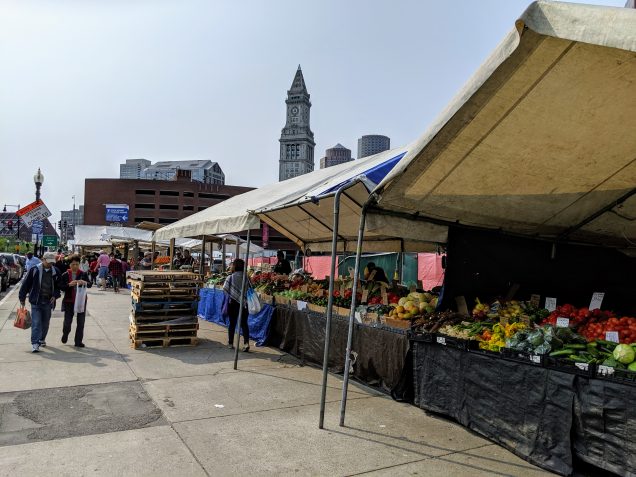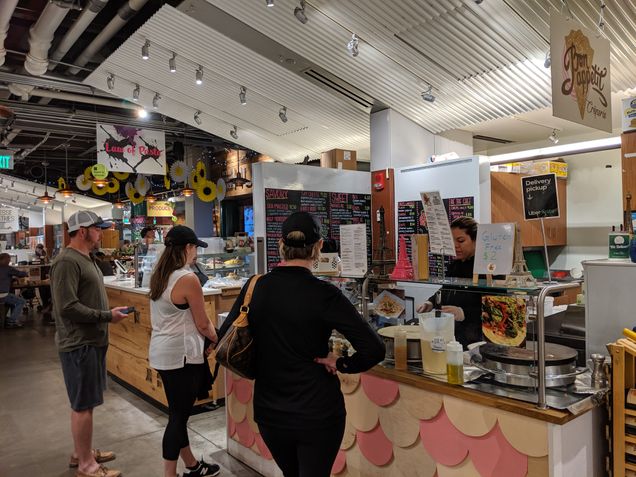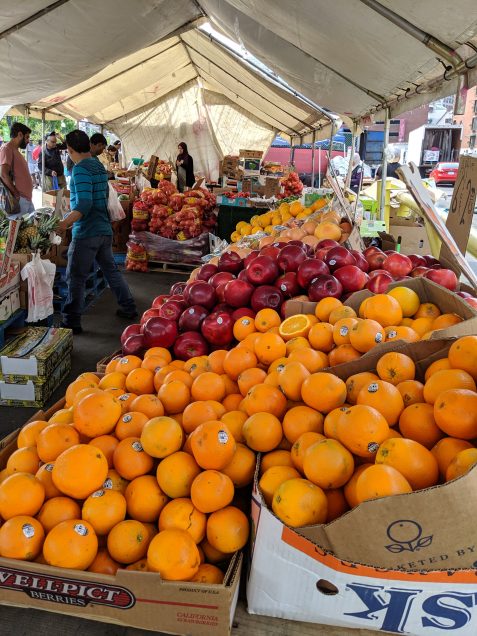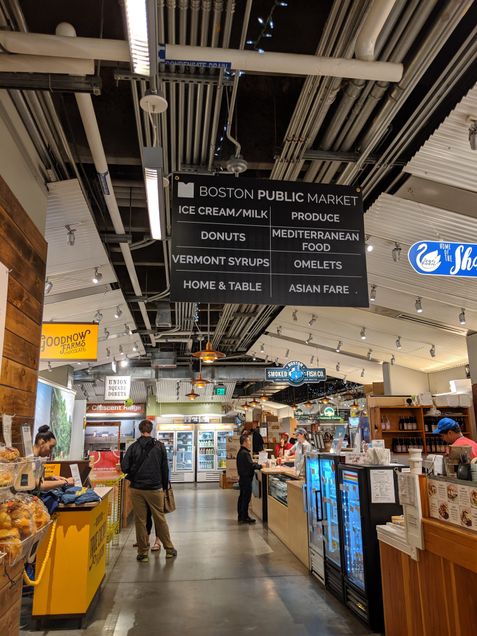No Two Markets are the Same
Students Karen Metheny’s summer course, Anthropology of Food (MET ML 641) are contributing guest posts. This example of participant observation comes from Gastronomy student Kate Cherven.

On Saturday, June 1st, I went to the Boston Public Market and Haymarket to conduct participant observation for two hours from 8:30 am until 10:30 am. These two locations are called “markets,” which are understood to be public spaces where people gather to sell and purchase goods, such as foodstuffs and other commodities. Yet, even though these two locations are called markets, their characteristics are very different from one another.

The Boston Public Market is an indoor food hall that provides specific branded stalls for different vendors to sell their products. Most of the products for sale in the Boston Public Market are: food prepared to eat right away, prepared food that can be taken to another location to be eaten, food to take home and prepare, as well as non-edible goods such as soap and yarn. The Boston Public Market is open year round and is available everyday from 7am until 8pm (Boston Public Market 2019). Haymarket is an outdoor market that is year round and is open Fridays and Saturdays from around 4am until 7pm (Market Tips 2019). The Haymarket stalls sell products that are mostly vegetables and produce, with some stalls selling seafood.
Thinking on Ray Oldenburg’s term “third place,” I wonder if Haymarket or the Boston Public Market can be considered “third places” (Lin 2012, 120). Oldenburg defines “third places” as locations that are “free or inexpensive, usually having food and drink, and being highly accessible for mixing and mingling in a comfortable atmosphere” (Lin 2012, 120). Haymarket fits this description in a few ways, because it is a space that is inexpensive and it is accessible for mixing and mingling, yet food and drink are not available on site for people to sit and share while socializing.

By comparing the social supportive resources outlined in Lin’s 2012 article, “Starbucks as the Third Place: Glimpses into Taiwan’s Consumer Culture and Lifestyles,” I claim that customers at Haymarket don’t receive these resources, therefore I don’t believe Haymarket would be considered a “third place” by Oldenburg’s description (Lin 2012, 120). Haymarket does not possess a pleasing and decorative space, a clean space, comfortable seating, nor cozy surroundings (2012, 122). Haymarket does possess a reputation as a historical and cultural site in Boston and is a tourist attraction (Experience 2019).
Yet, while Haymarket provides a space for social interactions, it does not create a space for people to sit and gather and build communal social relations. Anderson states in the book, Everyone Eats: Understanding Food and Culture, Second Edition, “People almost always eat as a social act” (2014, 138); therefore if Haymarket doesn’t provide a space for this social act, I don’t consider it a “third place.”

Boston Public Market seems to be a better match for “third place.” The Boston Public Market has a pleasing and decorative space, is clean, provides comfortable seating, enjoyable music, a prestigious reputation, and provides high quality products (Boston Public Market 2019). While I walked around, I noticed that the Boston Public Market has numerous gathering locations made from large communal tables, or standing tables where people are able to gather and consume their purchased products. Yet, the Boston Public Market doesn’t seem to fit the “third place” definition of being either free or inexpensive, with the majority of their products for sale being more than $5 USD. Yet, it is possible for a person to come into the Boston Public Market to sit and not buy anything, therefore it can be used as a free gathering space.
I found it interesting to observe two food spaces in Boston that are called “markets” yet are drastically different from one another. Haymarket is an outdoor space that provides raw food products for individuals to purchase and take home with them to prepare, while the Boston Public Market is an indoor space that provides mainly prepared meals for people to sit and enjoy within the space or take with them to other locations. When using Ray Oldenburg’s concept of a “third place,” I was able to understand how customers receive social supportive resources from food spaces and concluded that while the Boston Public Market would be considered a “third place,” I believe Haymarket would not. I’m not sure if there is a “fourth place” in which Haymarket would fit, but I find it interesting to conclude that even though these two food spaces are called “markets,” their social supportive resources are drastically different from one another.
Work Cited:
Anderson, E. N. 2014. Everyone Eats: Understanding Food and Culture, Second Edition. New York University Press, New York.
Boston Public Market. n.d.. Retrieved June 5, 2019. https://bostonpublicmarket.org/
Experience. n.d.. Retrieved June 6, 2019. http://www.haymarketboston.org/market-tips
Lin, En-Ying. 2012. Starbucks as the Third Place: Glimpses into Taiwan’s Consumer Culture and Lifestyles. Journal of International Consumer Marketing 24 (1-2), 119-128.
Market Tips. (n.d.). Retrieved June 6, 2019. http://www.haymarketboston.org/market-tips